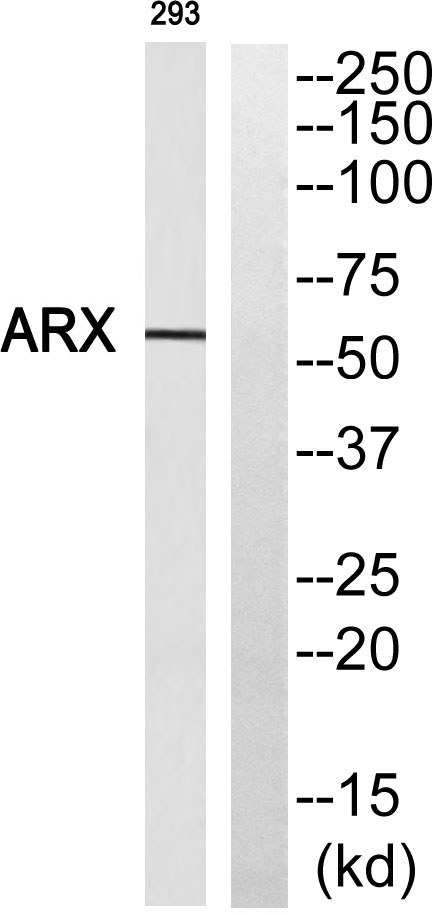产品名称
ARX Rabbit Polyclonal Antibody
别名
ARX; Homeobox protein ARX; Aristaless-related homeobox
蛋白名称
Homeobox protein ARX
存储缓冲液
Liquid in PBS containing 50% glycerol, 0.5% BSA and 0.02% New type preservative N.
Human Gene Link
http://www.ncbi.nlm.nih.gov/sites/entrez?db=gene&term=170302
Human Swissprot No.
Q96QS3
Human Swissprot Link
http://www.uniprot.org/uniprotkb/Q96QS3/entry
Mouse Gene Link
http://www.ncbi.nlm.nih.gov/sites/entrez?db=gene&term=11878
Mouse Swissprot No.
O35085
Mouse Swissprot Link
http://www.uniprot.org/uniprot/O35085
Rat Gene Link
http://www.ncbi.nlm.nih.gov/sites/entrez?db=gene&term=317268
Rat Swissprot Link
http://www.uniprot.org/uniprot/A6YP92
免疫原
Synthesized peptide derived from ARX . at AA range: 250-330
特异性
ARX Polyclonal Antibody detects endogenous levels of ARX protein.
稀释度
WB 1:500 - 1:2000. ELISA: 1:5000. Not yet tested in other applications.
宿主
Polyclonal, Rabbit,IgG
背景介绍
This gene is a homeobox-containing gene expressed during development. The expressed protein contains two conserved domains, a C-peptide (or aristaless domain) and the prd-like class homeobox domain. It is a member of the group-II aristaless-related protein family whose members are expressed primarily in the central and/or peripheral nervous system. This gene is thought to be involved in CNS development. Expansion of a polyalanine tract and other mutations in this gene cause X-linked mental retardation and epilepsy. [provided by RefSeq, Jul 2016],
组织表达
Expressed predominantly in fetal and adult brain and skeletal muscle. Expression is specific to the telencephalon and ventral thalamus. There is an absence of expression in the cerebellum throughout development and also in adult.
功能
disease:Defects in ARX are a cause of Partington syndrome (PRTS) [MIM:309510]; also known as X-linked syndromic mental retardation 1 (MRXS1). PRTS is characterized by mental retardation, episodic dystonic hand movements, and dysarthria.,disease:Defects in ARX are the cause of agenesis of corpus callosum with abnormal genitalia (ACC with abnormal genitalia) [MIM:300004]. ACC with abnormal genitalia consists of a brain and genital malformations syndrome.,disease:Defects in ARX are the cause of epileptic encephalopathy early infantile type 1 (EIEE1) [MIM:308350]; also known as myoclonic epilepsy X-linked with intellectual disability and spasticity, X-linked West syndrome or X-linked infantile spasm syndrome (ISSX). EIEE1 is a severe form of epilepsy characterized by frequent tonic seizures or spasms beginning in infancy with a specific EEG finding of suppression-burst patterns, characterized by high-voltage bursts alternating with almost flat suppression phases. Patients may progress to West syndrome, which is characterized by tonic spasms with clustering, arrest of psychomotor development, and hypsarrhythmia on EEG.,disease:Defects in ARX are the cause of lissencephaly X-linked type 2 (LISX2) [MIM:300215]; also known as lissencephaly X-linked with ambiguous genitalia (XLAG). LISX2 is a classic type lissencephaly associated with abnormal genitalia. LISX2 patients have severe congenital or postnatal microcephaly, lissencephaly, agenesis of the corpus callosum, neonatal-onset intractable epilepsy, poor temperature regulation, chronic diarrhea, and ambiguous or underdeveloped genitalia.,disease:Defects in ARX are the cause of mental retardation X-linked ARX-related (MRXARX) [MIM:300419]. Mental retardation is a mental disorder characterized by significantly sub-average general intellectual functioning associated with impairments in adaptative behavior and manifested during the developmental period.,function:Transcription factor required for normal brain development. May be important for maintenance of specific neuronal subtypes in the cerebral cortex and axonal guidance in the floor plate.,similarity:Belongs to the paired homeobox family. Bicoid subfamily.,similarity:Contains 1 homeobox DNA-binding domain.,similarity:Contains 1 OAR domain.,tissue specificity:Expressed predominantly in fetal and adult brain and skeletal muscle. Expression is specific to the telencephalon and ventral thalamus. There is an absence of expression in the cerebellum throughout development and also in adult.,
纯化
The antibody was affinity-purified from rabbit antiserum by affinity-chromatography using epitope-specific immunogen.


